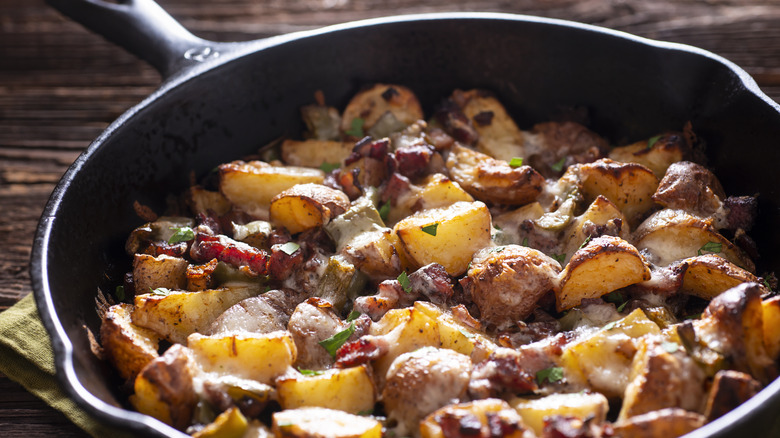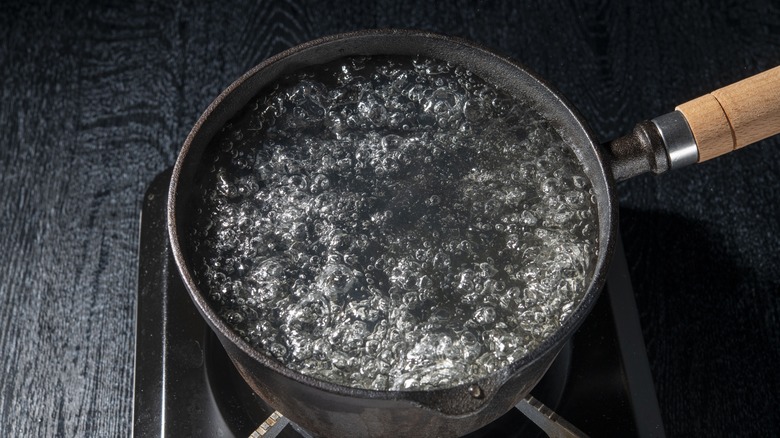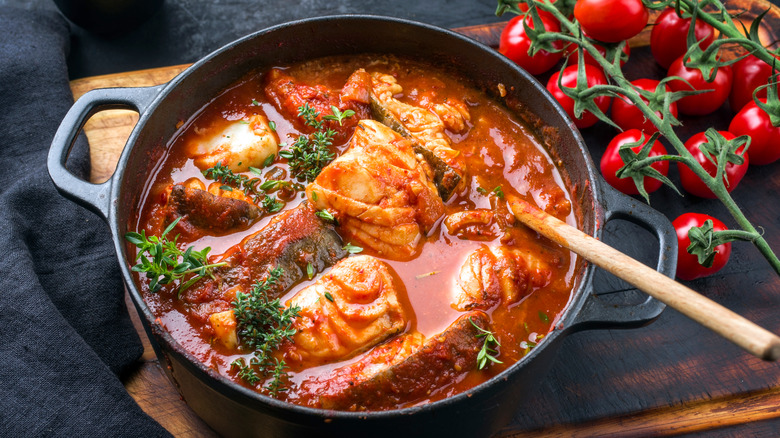Leaving Food In Your Cast-Iron Skillet Overnight Is A Huge Mistake
Many home cooks and chefs alike love cooking with a cast-iron skillet because it's a sturdy pan that keeps food hot for longer and prevents it from sticking. However, just because a cast-iron appears durable doesn't mean you can't ruin one if you're not careful. Just as with any kitchen tool, cast-iron skillets require care and the know-how to properly use them. Avoid making an elementary mistake that could ruin your food and worse — your skillet. For instance, you may be tempted to wrap a piece of tin foil over your leftovers and store them in your cast iron overnight. However, this would be a costly mistake for several reasons.
For one, the metal of the pan can affect the quality of your leftovers. Despite rumors to the contrary, cast-iron skillets won't cause a toxic level of iron to leak into your food, but small amounts of iron can make their way into your dish. As such, if you store your leftovers in your cast-iron skillet, you may find that they have a bitter metallic overtone similar to sucking on a penny. It's an unpleasant taste that can best be avoided by breaking out the microwave bowls.
Additionally, cast iron pans maintain their integrity by seasoning the pan. Leftover food can interfere with this protective barrier, opening up your cast-iron skillet to rust. Don't fret if you've previously stored food in your cast-iron as there's a surefire way to get it back to working order.
How to reseason a cast iron pan
It's the acidity in foods that is especially detrimental to the protective barrier of seasoning for your cast iron, which is why it's recommended not to keep food in one longer than it takes to cook. Cast-iron skillets will rust over time when exposed to moisture or air. Particularly, highly acidic ingredients are worrisome, which we will get to in a moment. If you've accidentally stripped the seasoning from your cast iron, then you can always reseason it through a fairly simple process.
While the culinary term is "seasoning," you're not actually using salt or any other blend of spices. Instead, you're coating your cast iron in a thin layer of vegetable oil, which when dry acts as a protective barrier and prevents food from sticking. Prior to reseasoning your pan, you will want to remove any rust or stuck-on food from your cast iron skillet. Rinse the pan with hot water and soap. Use a pan scraper to get any bits of particularly stuck-on smudges or burnt food. Make sure that your skillet is completely dry.
You can preseason your pan either via stovetop or via the oven. You will want to coat your cast-iron skillet in vegetable oil and let it heat up in the pan over a high temp. From there, let your skillet cool and wipe away any excess. Now, your cast iron skillet is good to go again. Just avoid any other blunders.
Foods you should never cook in a cast iron pan
While you should never leave leftovers in your cast-iron skillet, there are some foods that you should probably avoid cooking in your pan altogether. As mentioned above, highly acidic foods, are a big no-no for much of the same reason why you shouldn't leave leftovers in your cast iron. High-acidic foods strip the protective seasoning that your cast iron needs. Tomatoes may be one of the worst offenders since the fruit has a high acid level. It's probably best not to use your cast-iron skillet as a saucepan and instead go with an alternative non-stick pan, instead.
Likewise, you may want to skip cooking fish in your cast-iron skillet or really any seafood at all. Cast-iron skillets have an absorptive property, meaning certain tastes will linger in the metal. That steak or pork chops might end up with a fishy aftertaste if you've previously cooked fish in the skillet. For the same reason, you should probably avoid using cast-iron skillets for anything particularly potent or smelly.
Some families treat cast-iron skillets like family heirlooms. But, if you're working with a new cast iron you just bought at the store, avoid any sticky foods for the time being. Cast-iron pans build up their non-stick properties over time by repeat seasonings of the skillet. As such, your food may end up sticking to the bottom of the pan.


